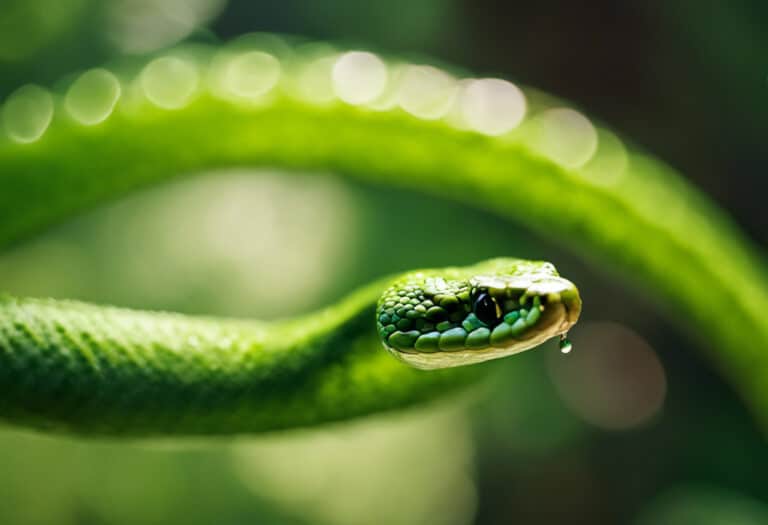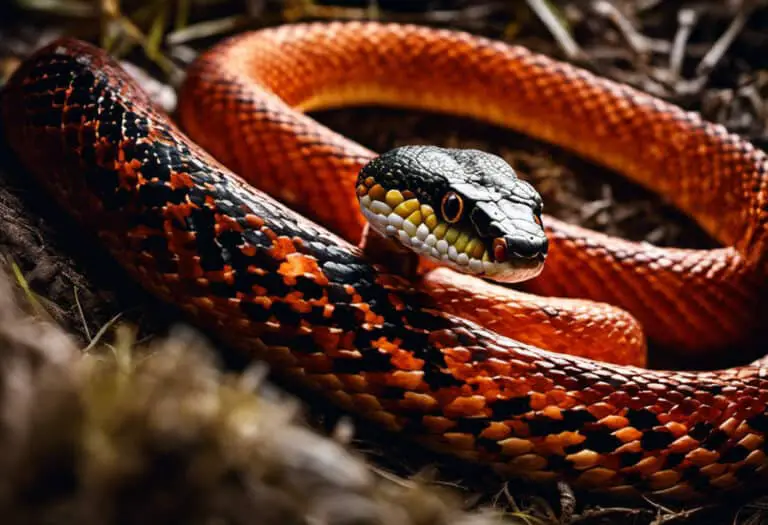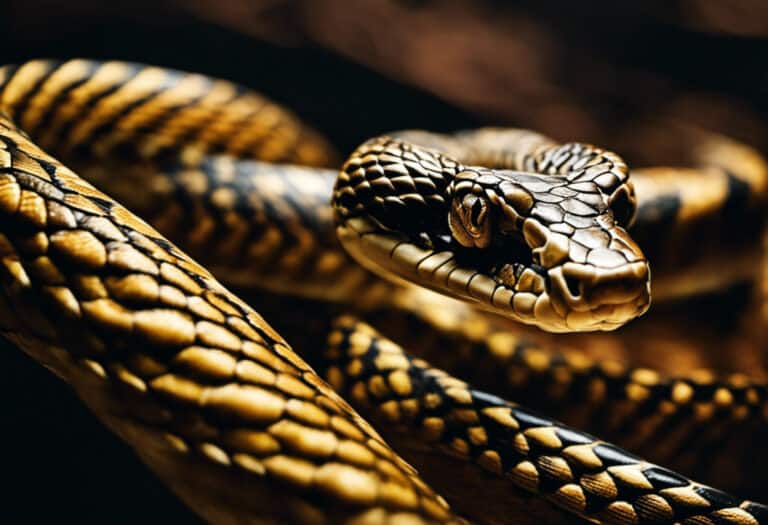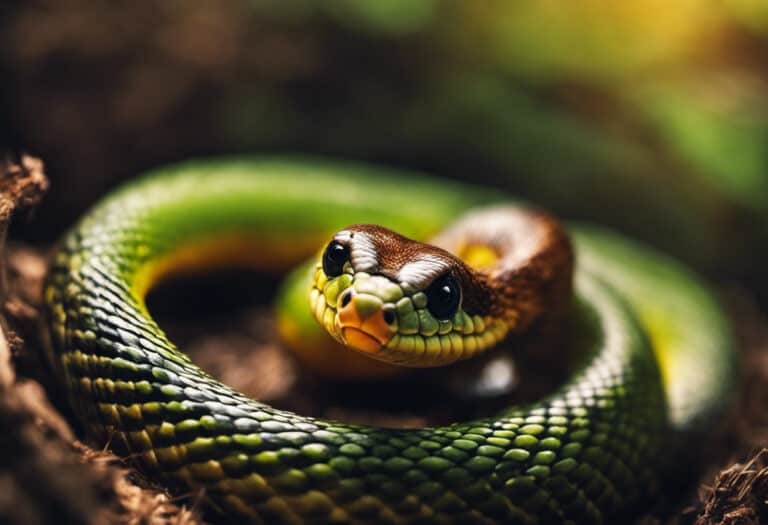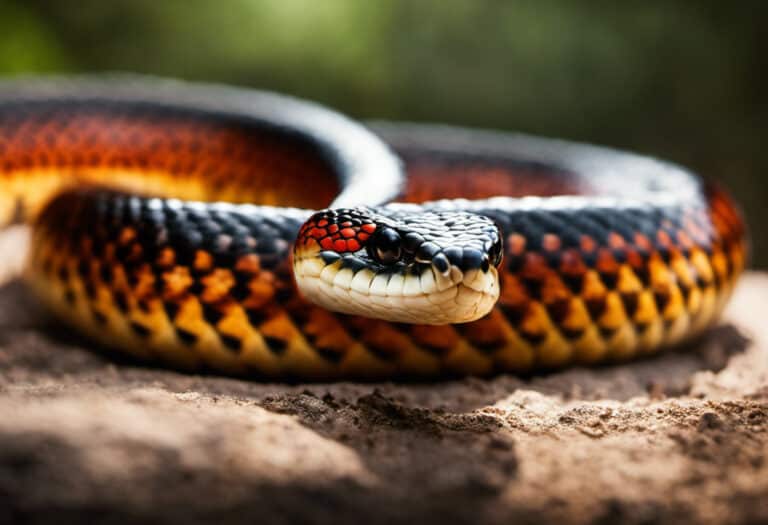What Do Ring Snakes Eat?
Imagine yourself deep in the heart of a dense forest, surrounded by the serenity of nature. As you observe the mysterious ringneck snakes slithering through the undergrowth, you can’t help but wonder, what do they eat?
Well, wonder no more! In this article, we will delve into the fascinating world of ringneck snake diets. These voracious eaters have a wide-ranging palate, feasting on everything from earthworms to small insects, slugs, snails, and even tiny amphibians.
Get ready to uncover the secrets of their culinary preferences!
Key Takeaways
- Ring snakes have a varied diet consisting of insects, earthworms, slugs, snails, and small vertebrates such as frogs and lizards.
- In captivity, ring snakes can be fed live insects, small rodents, birds, amphibians, and fish.
- Ring snakes use their sense of smell to locate prey and employ stealth and patience in their hunting techniques.
- Factors such as prey availability, habitat, seasonal variations, and hunting strategies affect the food choices of ring snakes.
Diet of Ring Snakes
Ring snakes, commonly known as ringneck snakes, have a diverse diet that consists of various prey items. Their prey preferences include insects, such as ants, beetles, and caterpillars, as well as worms and small amphibians.
These snakes utilize different foraging strategies to capture their prey. They’re known to actively search for food on the ground, often flipping over rocks and logs to find hidden insects and worms. Ring snakes also employ a unique hunting technique called constriction, where they coil their bodies around small amphibians, such as frogs and salamanders, to immobilize and consume them.
This foraging strategy allows them to efficiently capture and consume their preferred prey. Overall, ring snakes exhibit a flexible diet and employ various foraging strategies to fulfill their nutritional needs.
Feeding Habits of Ring Snakes
If you’re wondering about the feeding habits of these snakes, they primarily consume small insects and other invertebrates. Ring snakes have a unique feeding behavior and prey selection. Here are five fascinating aspects of their feeding habits:
- Ambush predators: Ring snakes are known for their ability to lay in wait and ambush their prey. They patiently hide and strike when an unsuspecting insect or invertebrate comes within their reach.
- Quick strikes: These snakes have lightning-fast reflexes when it comes to capturing their prey. In a split second, they can lunge forward and snatch their target.
- Constriction: Once the ring snake captures its prey, it uses its body to constrict and immobilize it. This constriction ensures that the prey can’t escape.
- Swallowing whole: After successfully immobilizing its prey, the snake begins the process of swallowing it whole. Its flexible jaw and expandable throat allow it to consume prey much larger than its own head.
- Digestive efficiency: Ring snakes have an efficient digestive system that allows them to extract maximum nutrients from their prey. They’ve a high metabolic rate, enabling them to digest their food quickly and efficiently.
These feeding behaviors and prey selection make ring snakes highly adaptable and successful predators in their environment.
Food Sources for Ring Snakes
You might be curious about what kind of food sources are available for these snakes.
Ring snakes, also known as ringneck snakes, have a diverse diet that allows them to thrive in various habitats. Their optimal prey selection is influenced by their size and habitat.
These snakes mainly feed on small invertebrates like earthworms, slugs, snails, and insects. They’re also known to consume small amphibians, such as frogs and salamanders.
Ring snakes have a specialized diet that includes a wide range of prey items, which contributes to their dietary diversity. This ability to adapt and consume a variety of food sources allows ring snakes to survive and flourish in diverse environments.
Their flexible feeding habits are essential for their survival and demonstrate their ability to find and consume prey efficiently.
Preferred Prey of Ring Snakes
When it comes to their preferred prey, ring snakes primarily feed on small invertebrates like earthworms, slugs, snails, and insects.
These creatures serve as the main source of nutrition for ring snakes, satisfying their hunger and providing the necessary energy to survive. The ring snake’s prey preferences are an integral part of their feeding patterns, allowing them to thrive in their natural habitat.
- Earthworms: These slimy creatures are a favorite among ring snakes, providing them with a nutritious meal packed with essential nutrients.
- Slugs: Ring snakes have a keen eye for slugs, using their specialized jaws to consume these slow-moving gastropods.
- Snails: With their sharp teeth, ring snakes can easily break through the shell of snails, devouring their soft bodies.
- Insects: From spiders to beetles, ring snakes are skilled hunters of various insects, ensuring a diverse diet and a balanced intake of nutrients.
Nutritional Requirements of Ring Snakes
Ring snakes, like any other snake species, have specific nutritional requirements to support their growth, reproduction, and overall health. These requirements are met through a diet consisting primarily of small vertebrates, such as frogs, lizards, and small mammals.
Optimal Food Sources
To ensure proper nutrition for ringneck snakes, it’s best to provide them with a variety of small invertebrates. These snakes have optimal prey selection and employ various foraging strategies to meet their dietary needs. Here are five examples of the ideal food sources for ringneck snakes:
- Earthworms: These slender, segmented creatures are a staple in the diet of ringneck snakes. They can be easily found in moist soil and provide a good source of protein.
- Slugs: Ringneck snakes are known to feed on slugs, which are soft-bodied mollusks. Slugs can be found in damp areas, such as gardens or under rocks.
- Insects: Ringneck snakes have a preference for small insects like ants, beetles, and caterpillars. These creatures offer a diverse range of nutrients and are abundant in nature.
- Spiders: Ringneck snakes have been observed consuming various spider species. The spiders’ small size makes them an accessible and nutritious food option.
- Crickets: These jumping insects are an excellent choice for ringneck snakes due to their high protein content. Crickets can be found in grassy areas or near plants.
Nutrient Deficiencies Prevention
To prevent nutrient deficiencies in your ringneck snake, make sure to provide a diverse diet of small invertebrates. Ringneck snakes have specific nutritional needs that must be met in order to maintain their health and vitality.
These snakes primarily feed on small invertebrates such as earthworms, slugs, snails, and insects. It’s important to offer a variety of prey items to ensure that your snake receives all the necessary nutrients. This diversity can help prevent deficiencies and promote overall well-being.
In addition to their primary diet, you can also include occasional treats like pinky mice or fish. It’s crucial to monitor your snake’s dietary intake and make adjustments as needed to ensure they receive a balanced and nutritious diet.
Dietary Adaptations in Captivity
In order to meet the dietary needs of your ringneck snake in captivity, it’s important to provide a varied and nutritious diet. These snakes have specific dietary preferences that must be taken into account when feeding them in captivity. Here are five items that can create an imagery of a diverse and fulfilling diet for your ringneck snake:
- Live insects: Crickets, mealworms, and waxworms are excellent sources of protein for your snake.
- Small rodents: Mice and rats can be offered to your snake, as they’re natural prey items for them.
- Birds: Offering small birds as food can provide a different texture and taste to their diet.
- Amphibians: Frogs and toads can be included in their diet, as they’re part of their natural prey in the wild.
- Fish: Feeding your snake small fish can provide essential nutrients such as omega-3 fatty acids.
Hunting Behavior of Ring Snakes
Ring snakes use their sense of smell to locate their prey. These snakes have a keen ability to detect scent molecules in the air, allowing them to track down potential meals.
When it comes to hunting techniques, ring snakes are known for their stealth and patience. They rely on their small size and ability to move silently through grass and leaves to surprise their prey. Once they’ve located their target, they strike quickly and efficiently, using their sharp teeth to secure their prey.
Ring snakes are opportunistic hunters, meaning they’ll eat a variety of prey depending on what’s available in their environment. However, their prey selection is typically small invertebrates such as worms, slugs, and insects.
Overall, ring snakes demonstrate impressive hunting skills and adaptability in their quest for food.
Digestive System of Ring Snakes
You might be surprised to learn that ring snakes have a highly efficient digestive system. Their digestive system function is specifically adapted for the consumption and absorption of nutrients. Here are some key aspects of their digestive system:
- Acidic stomach: Ring snakes have a stomach that produces strong acids to break down food quickly and efficiently.
- Long intestines: Their intestines are longer than their bodies, allowing for extended nutrient absorption.
- Enzymatic digestion: Ring snakes secrete enzymes that aid in breaking down proteins, fats, and carbohydrates.
- Efficient nutrient absorption: The lining of their intestines is highly specialized to maximize nutrient absorption.
- Rapid digestion: Ring snakes can digest their prey within a few hours, ensuring quick access to vital nutrients.
With these adaptations, ring snakes are able to efficiently extract nutrients from their food, ensuring their survival and freedom to roam their natural habitats.
Factors Affecting Ring Snake Food Choices
When it comes to food choices, factors such as prey availability, habitat, and seasonal variations play a significant role for ring snakes. These factors influence the prey selection of ring snakes, determining what they eat in their natural habitats.
The impact of habitat on food availability cannot be understated, as different environments offer different prey options.
For example, ring snakes found in forested areas may have access to a variety of small mammals, birds, and amphibians, while those inhabiting grasslands might primarily feed on insects and other invertebrates.
Seasonal variations also affect food availability, with ring snakes adjusting their diet to match the abundance of certain prey items during different times of the year.
Overall, the food choices of ring snakes are intricately connected to the factors present in their habitat, allowing them to adapt and thrive in their environments.
| Factors Influencing Prey Selection | Impact of Habitat on Food Availability | Seasonal Variations |
|---|---|---|
| Prey availability | Presence of suitable prey species | Abundance of prey |
| Hunting strategies | Availability of hunting grounds | Availability of |
| specific prey |
Table 1: Factors influencing ring snake food choices.
Conservation Implications for Ring Snake Food Web
Understanding the conservation implications of the ring snake’s place within the food web is crucial for protecting their habitat and ensuring their survival.
These implications are significant, as the ring snake plays a vital role in maintaining the balance of the ecosystem. Conservation strategies must be implemented to safeguard the ring snake’s food sources and habitat.
Ring snakes primarily feed on insects, such as spiders, beetles, and ants. They also consume small amphibians, such as frogs and salamanders.
Additionally, ring snakes prey on small mammals, including mice and voles. They’re known to consume earthworms, which contribute to soil health. Their diet may also include other snake species, further regulating the population dynamics within the ecosystem.
Frequently Asked Questions
How Do Ring Snakes Locate Their Prey?
Ring snakes locate their prey through sensory mechanisms, such as heat detection and chemical cues. With their hunting behavior, they use their tongue to sense scents in the environment, helping them find and capture their food.
Are Ring Snakes Opportunistic Feeders or Do They Have Specific Hunting Strategies?
Ring snakes are opportunistic feeders, meaning they take advantage of available prey. They do not have specific hunting strategies. Their feeding habits and hunting behavior depend on the circumstances and opportunities that arise in their environment.
What Role Does the Size of the Prey Play in the Ring Snake’s Diet?
The size of the prey plays a crucial role in the ring snake’s diet. The impact of prey size on ring snake feeding is significant, as it determines the efficiency of their hunting and the amount of energy they can acquire.
Are There Any Specific Environmental Factors That Influence the Availability of Food for Ring Snakes?
Environmental factors, such as temperature, humidity, and habitat type, can greatly impact the availability of food for ring snakes. These conditions influence the presence and abundance of prey species, ultimately shaping the diet of ring snakes.
Do Ring Snakes Have Any Predators That Target Them While They Are Hunting or Consuming Their Prey?
While hunting or consuming their prey, ring snakes may face predation from certain predators. These predator-prey interactions play a crucial role in shaping the hunting behavior and survival strategies of ring snakes in their natural environment.
Conclusion
In conclusion, ringneck snakes exhibit a remarkable ability to adapt their diet to the available food sources in their natural habitats. Their diverse menu includes earthworms, small insects, slugs, snails, and even small amphibians.
Their culinary preferences play a crucial role in their survival and thriving. Understanding the factors that affect their food choices can have important implications for their conservation.
The intricate world of ringneck snake dietary choices is truly fascinating and worth exploring further.

